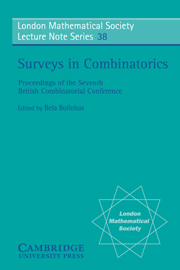Book contents
- Frontmatter
- Contents
- PREFACE
- 1 Resonance and reconstruction
- 2 Symmetry conditions in graphs
- 3 Extremal hypergraph problems
- 4 Connectivity and edge-connectivity in finite graphs
- 5 Partition theory and its applications
- 6 Strongly regular graphs
- 7 Geometries in finite projective and affine spaces
- 8 Long cycles in digraphs with constraints on the degrees
- 9 Colouring problems and matroids
- Index
1 - Resonance and reconstruction
Published online by Cambridge University Press: 17 March 2010
- Frontmatter
- Contents
- PREFACE
- 1 Resonance and reconstruction
- 2 Symmetry conditions in graphs
- 3 Extremal hypergraph problems
- 4 Connectivity and edge-connectivity in finite graphs
- 5 Partition theory and its applications
- 6 Strongly regular graphs
- 7 Geometries in finite projective and affine spaces
- 8 Long cycles in digraphs with constraints on the degrees
- 9 Colouring problems and matroids
- Index
Summary
SUMMARY
This article is another attempt to reconcile part of graph theory and part of theoretical physics. Specifically, we shall discuss some aspects of the reconstruction problem in terms of simple models of physical phenomena. A previous essay in the same vein (Biggs 1977a, henceforth referred to as IM) may be consulted for background information and proofs of some basic theorems.
There are four sections: (1) Interaction Models, (2) the Algebra of Graph Types, (3) Reconstruction, (4) Partition Functions for Infinite Graphs.
INTERACTION MODELS
Definitions
Let G be a finite (simple) graph, with vertex set V and edge-set E. An ‘interaction model’ on G arises when the vertices of G may have certain attributes, and they interact along the edges according to the values of those attributes. To be more precise, let A denote a finite set of objects (attributes), and define a state on G to be a function ω: V → A. In graph theory, we often think of the attributes as colours, so that a state is a colouring. In theoretical physics, the vertices represent particles of some kind, and the attributes represent some physical property, such as a magnetic moment.
The interaction between a pair of adjacent vertices is measured by a real-valued function i, called the interaction function, defined on the set A(2) of unordered pairs of attributes. That is, i{a1,a2) measures the interaction between a pair of vertices when they are joined by an edge and they have attributes a1 and a2. An interaction model M is a pair (A,i), where A is a finite set and i is an interaction function.
Information
- Type
- Chapter
- Information
- Surveys in Combinatorics , pp. 1 - 21Publisher: Cambridge University PressPrint publication year: 1979
